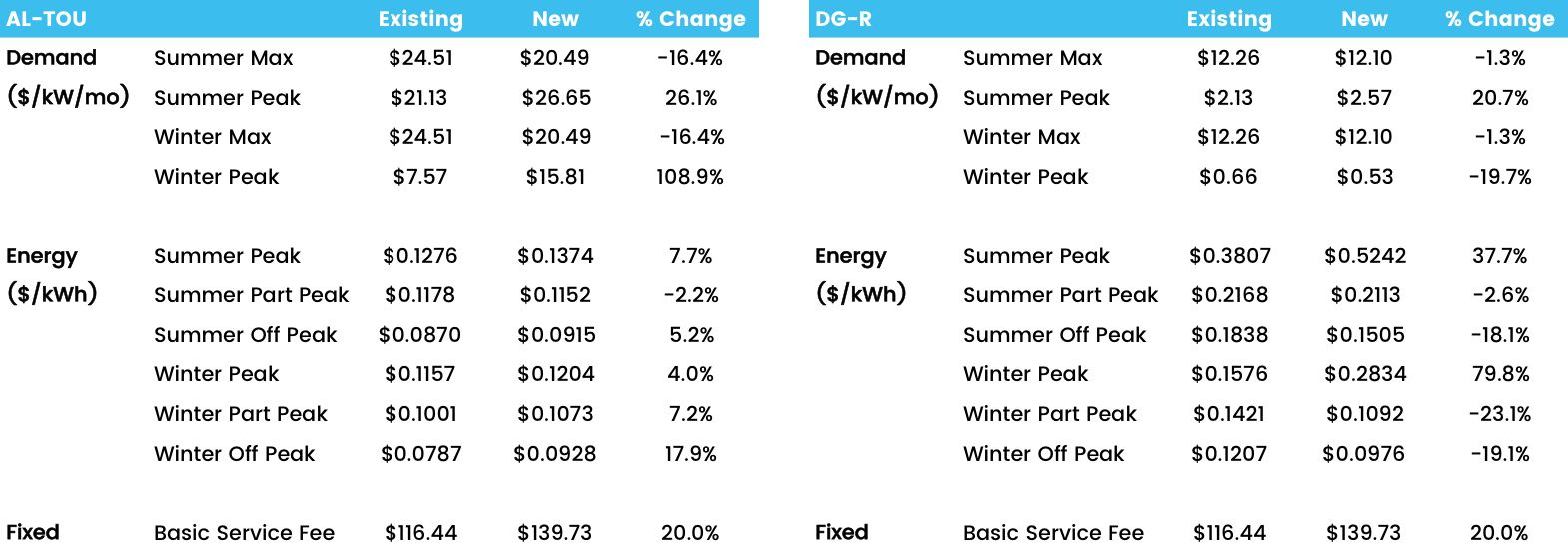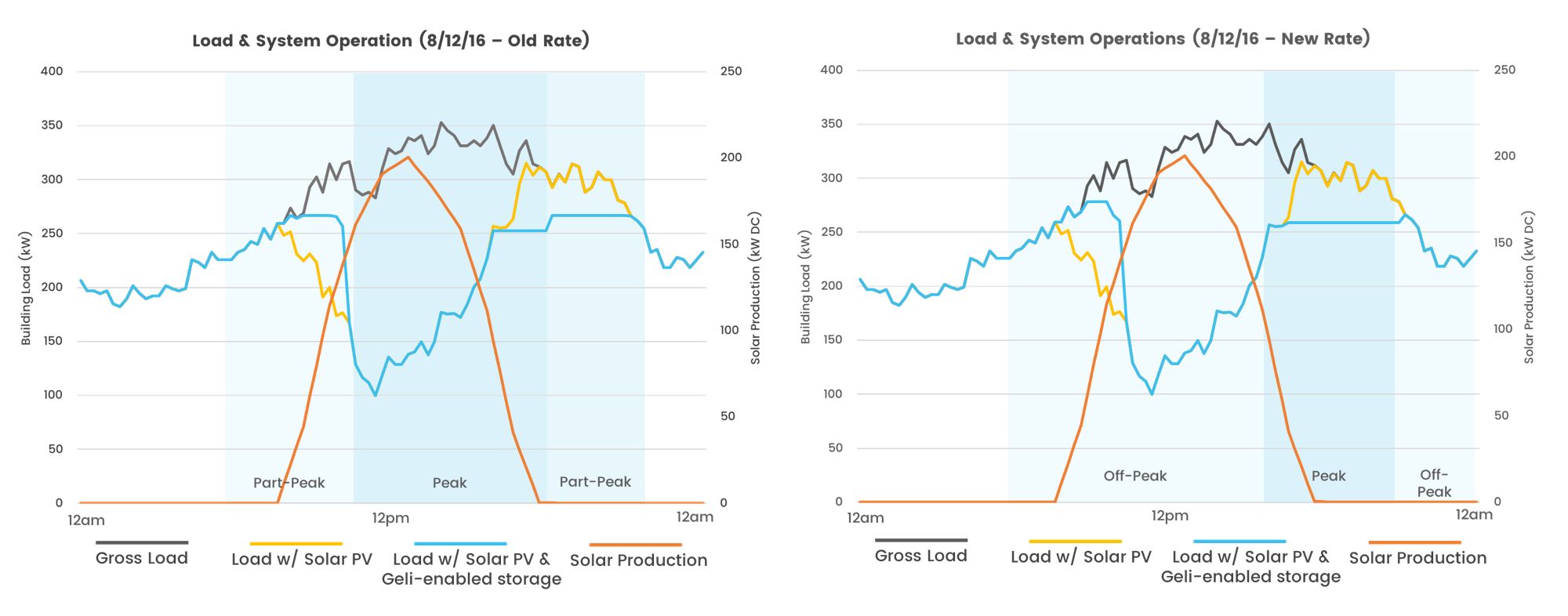On December 1, San Diego Gas & Electric became the first of California’s investor-owned utilities to implement a new time-of-use period that shifts the peak period later into the evening, to align with the "head" of the duck curve.
Commercial, institutional and industrial customers in SDG&E territory are subject to some of the most expensive demand charges in the country, making it an attractive market for demand-charge management. Unlike residential customers, many non-residential customers are subject to demand charges that are billed based on the facility’s highest monthly demand (measured in kilowatts), which can often exceed half of their total monthly utility bill. An energy storage system optimized for demand-charge management can reduce demand charges by forecasting when the load will spike and then discharging the energy storage system to mitigate the peaks measured by the utility meter.
Many customers on the General Service tariff (Schedule AL-TOU) have been able to bypass these expensive demand charges by installing solar PV and switching to an alternative distributed generation tariff (Schedule DG-R). DG-R’s less expensive demand charges are offset by more expensive energy charges during the peak period, which has, up until now, coincided with peak solar production hours. With net metering, excess solar production has been credited back at the peak energy rate, which made the tariff switch to DG-R a win-win proposition for the solar customer. But now that's changing.
Tariff comparison: New versus old
SDG&E’s new tariffs shift the summer peak period to later in the evening, shorten the summer season, expand winter peak hours, and extend the time-of-use (TOU) periods to include weekends. "Part-Peak" and "Off-Peak" have been renamed "Off-Peak" and "Super Off-Peak" respectively, with an additional "Super Off-Peak" period introduced in March and April.
Comparison of SDG&E TOU Periods

Energy, demand and fixed charges have gone up almost entirely across the board for both AL-TOU and DG-R. For customers on AL-TOU, demand charges during peak time have increased 26 percent in the summer and 109 percent in the winter, while maximum demand charges have gone down by 16 percent.
The difference between Peak and Off-Peak energy charges has narrowed, reducing the potential for energy arbitrage. On DG-R, peak energy charges have jumped up 38 percent in the summer to $0.5242 per kilowatt-hour and 80 percent in the winter to $0.2834 per kilowatt-hour. These tariff changes will most significantly impact recent and prospective solar customers, as TOU grandfathering only applies to ratepayers that filed an interconnection application prior to January 31, 2017.
Comparison of SDG&E Rates

Impact on solar savings
Geli compared the impact of the new rates and TOU periods across 15 different facilities, including big-box stores, hotels, grocery stores, office buildings and schools. Solar savings decreased for all 15 sites, with an average decrease of 26.2 percent on DG-R and 5.7 percent on AL-TOU.
 This steep decrease in DG-R solar savings is illustrated in the example site analysis below, with nearly 40 percent of peak period solar production shifted to off-peak under the new TOU periods. Given that, peak energy credits are significantly more valuable than off-peak credits.
This steep decrease in DG-R solar savings is illustrated in the example site analysis below, with nearly 40 percent of peak period solar production shifted to off-peak under the new TOU periods. Given that, peak energy credits are significantly more valuable than off-peak credits.

The case for solar-plus-storage
Although SDG&E’s new tariffs will negatively impact the economics of most standalone solar PV projects, they strengthen the economics for solar-plus-storage systems. Between the peak period shifting later to line up with evening demand and the increase in peak demand charges, the value of demand-charge management has increased significantly.
Contrary to the traditional strategy of switching to DG-R, most sites in our analysis saw an overall lower utility bill by staying on AL-TOU. This can be attributed to the following reasons:
- The DG-R baseline bill is substantially higher than that of AL-TOU
- AL-TOU solar savings decreased less dramatically
- Demand-charge management savings are much higher on AL-TOU
Within the portfolio of sites we analyzed, solar-plus-storage systems produced a median bill decrease of 23 percent with the switch to DG-R, and a decrease of 31 percent by remaining on AL-TOU. For the example below, this translates to roughly $50,000 per year more in savings and total bill savings of nearly $79,000 per year. Even when considering the potential added value of TOU arbitrage present on DG-R, solar-plus-storage on AL-TOU still provides the best outcome for the customer.

For the purposes of this article, solar-plus-storage systems were sized to 25 percent of max load and solar sized to 90 percent of annual consumption. Note also that Geli’s analytics software does not size systems as a percentage of load, but rather for maximum economic benefit.
What does this mean for energy customers in California?
If you or your customer is considering installing an on-site solar PV system, not adding energy storage leaves significant additional bill savings on the table, especially now that solar PV is worth far less during peak production hours.
If you want to know exactly what solar-plus-storage is worth, sign up for Geli ESyst, Geli’s free-to-use solar-plus-storage site analysis tool, which already has SDG&E’s new TOU rates integrated. Geli will also be exhibiting at GTM's U.S. Energy Storage Summit 2017, to be held December 12-13 in San Francisco.
***
Kevin Diau is a sales engineer at Geli. Kevin joined Geli after completing a BS/MS in renewable energy systems at Stanford University. Kevin is also the writer and director of Pacific Powerhouses, a documentary that details the opportunity and challenges in deploying renewable energy systems on Pacific islands.
Geli, which stands for Growing Energy Labs, Inc., provides the energy storage industry’s only design-to-automation platform, linking site analytics with the real-world operations. Founded in 2010, Geli software automates large-scale demand-charge management systems in the United States, resilient microgrids on remote islands, and virtual power plants for utilities.




